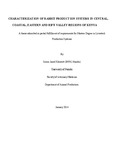| dc.description.abstract | To characterize rabbit production systems, a study was conducted in five counties within four regions of Kenya with significant rabbit farming. These included: Rift valley (Nakuru county), Central (Kiambu and Nyeri counties), Eastern (Meru county) and Coast (Taita Taveta county). Data were obtained through a field survey, questionnaires and personal observations between August and September 2011. This study covered the key areas of rabbit production such as: General farm details, number of rabbits, breeds and breeding practices, housing, feeds and feeding practices, diseases and disease control, constraints to production and recommendations appertaining to the key production challenges. Results showed that rabbit production in Kenya was mainly small scale (84.8%) principally for income generation and home consumption (89.6%). The rabbit breeds kept included: New Zealand White (29%), Crossbreds (24%), Californian white (12%), Chinchilla (11.5%), Dutch (8%) Flemish giant (5.5%) and French lop (4%), with the main breeding stocks being selected from own stocks or from the neighboring farms (90%). The majorities (75%) of the rabbits on farms were owned by either the household heads or by the spouses as opposed to children as it had been recorded in the past. However, at the coastal region (Taita Taveta county), rabbits were mainly kept by young people (54%) (sons) in contrast to other counties such as central (Nyeri) where only 1.7% of rabbit owners were
xv
young. Majority of the farmers (76.7%) had encountered at least one rabbit disease/symptom at the farm in the six months preceding the study period. The main rabbit diseases included; diarrhea (21%), mange (13.3%), bloat (11%), ear canker (10.6%) and pneumonia (10%). Disease control measures were practiced by only 43% of the farmers due to un-availability of either veterinary drugs or information on rabbit diseases.
The five most important challenges to rabbit farming were: Lack of market for rabbits (51%), inadequate husbandry knowledge (28%), lack of quality breeding stocks (15.5%), insufficient funds for expansion (11%) and lack of rabbit feeds (8.7%). In conclusion, small scale rabbit production system were predominant, aimed at home consumption and income generation. The main cited challenges to production were: Lack of market for rabbits, inadequate husbandry knowledge, lack of quality breeding stocks, insufficient funds for expansion and lack of rabbit feeds. In order to address these challenges, some farmer suggested intervention measures were recorded as follows: Better rabbit breeding stocks should be introduced to the farmers through registered breeders, farmers should be trained on proper rabbit husbandry practices, sensitization of the Kenyan population on the benefits of rabbit meat and rabbit production should be conducted, and last but not least, research on rabbit feeding and disease management should be intensified and facilitated so as to inform rabbit production practices. | en_US |

